Quote and images of the month 11.2019
Posted on UTC 2019-11-01 07:27
Robert Frost, The Star-Splitter (1923)
'You know Orion always comes up sideways.
Throwing a leg up over our fence of mountains,
And rising on his hands, he looks in on me
Busy outdoors by lantern-light with something
I should have done by daylight, and indeed,
After the ground is frozen, I should have done
Before it froze, and a gust flings a handful
Of waste leaves at my smoky lantern chimney
To make fun of my way of doing things,
Or else fun of Orion's having caught me.
Has a man, I should like to ask, no rights
These forces are obliged to pay respect to?'
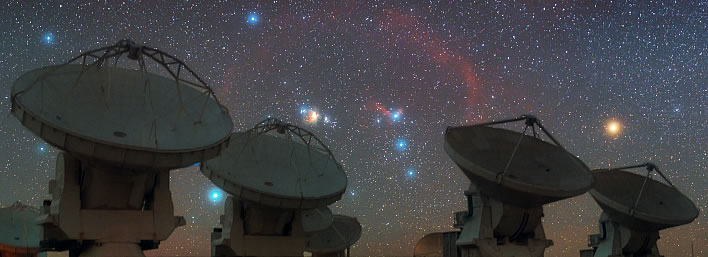
The constellation of Orion throwing a leg over some of the 66 antennae of the Atacama Large Millimeter Array (ALMA), high on the Chajnantor Plateau in the Chilean Andes. The location is in the southern hemisphere, of course, so Orion is upside down for northern eyes: here he is throwing his right leg over the array – in the northern hemisphere it would be his left leg. Even to the naked eye, the dry desert air of the high plateau allows us to see the Orion nebula (a.k.a Messier 42). It is the middle one of the three objects that make up the line of Orion's sword, the bright yellow-orange blur just above the second antenna from the left. We cannot miss the red supergiant star Betelgeuse (Alpha Orionis) just above the fourth antenna. The red semicircle at top centre is a structure known as Barnard's Loop. Image: ESO [Click to open a larger image in a new browser tab.]
So Brad McLaughlin mingled reckless talk
Of heavenly stars with hugger-mugger farming,
Till having failed at hugger-mugger farming,
He burned his house down for the fire insurance
And spent the proceeds on a telescope
To satisfy a life-long curiosity
About our place among the infinities.
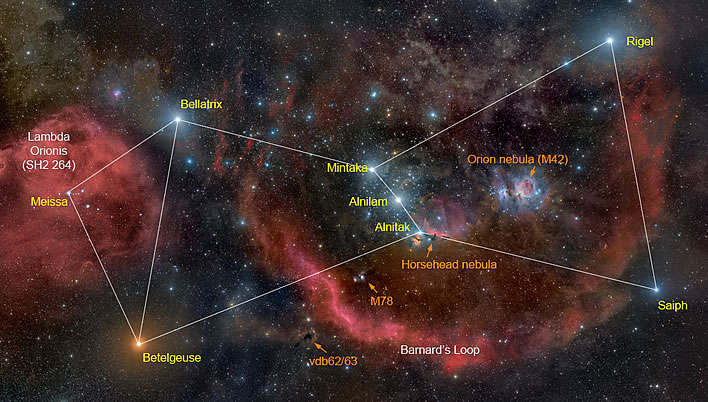
A view of the Orion constellation from the northern hemisphere, with its main features marked. For the naked eye the striking three-star 'belt', the bright red Betelgeuse and the very bright blueish star Rigel make the constellation one of the easiest ones to find in the night sky. The cosmic detail shown here would, of course, be only vaguely visible to the naked eye even in optimal conditions. Image: ©Rogelio Bernal Andreo.
'What do you want with one of those blame things?'
I asked him well beforehand. 'Don't you get one!'
'Don't call it blamed; there isn't anything
More blameless in the sense of being less
A weapon in our human fight,' he said.
'I'll have one if I sell my farm to buy it.'
There where he moved the rocks to plow the ground
And plowed between the rocks he couldn't move
Few farms changed hands; so rather than spend years
Trying to sell his farm and then not selling,
He burned his house down for the fire insurance
And bought the telescope with what it came to.
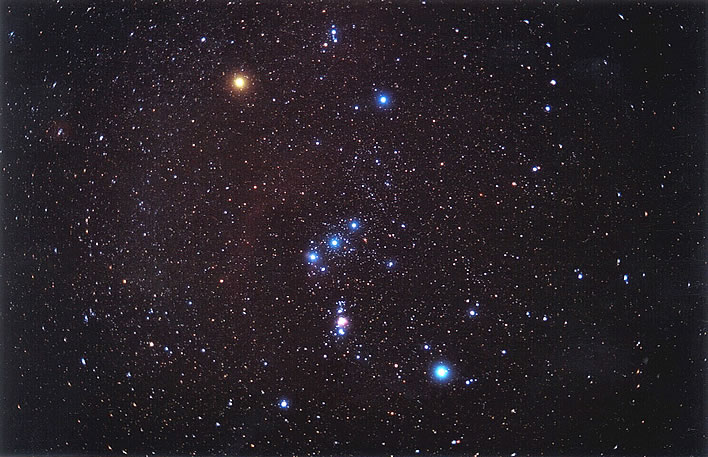
A low resolution, earthbound image of the constellation of Orion as it would be seen in the middle of the night, both legs by now having been thrown fully over the horizon. The characteristic markers noted previously are clearly visible: the red supergiant star Betelgeuse, top left; the belt, centre; the Orion nebula in the middle of the sword below the belt and the bright blueish star Rigel near the bottom. Image: ©Matthew Spinelli / NASA.
He had been heard to say by several:
'The best thing that we're put here for's to see;
The strongest thing that's given us to see with's
A telescope. Someone in every town
Seems to me owes it to the town to keep one.
In Littleton it may as well be me.'
After such loose talk it was no surprise
When he did what he did and burned his house down.
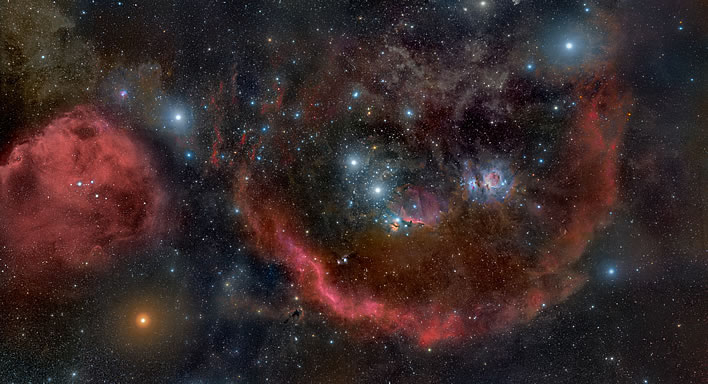
Our telescopes grow more powerful almost by the year. Modern earthborne and space telescopes operating on spectra from microwave to x-ray reveal the immense and complex structure of that area of space that we call the Orion constellation. Image: ©Rogelio Bernal Andreo. [Click to open a larger image in a new browser tab.]
Mean laughter went about the town that day
To let him know we weren't the least imposed on,
And he could wait—we'd see to him to-morrow.
But the first thing next morning we reflected
If one by one we counted people out
For the least sin, it wouldn't take us long
To get so we had no one left to live with.
For to be social is to be forgiving.
Our thief, the one who does our stealing from us,
We don't cut off from coming to church suppers,
But what we miss we go to him and ask for.
He promptly gives it back, that is if still
Uneaten, unworn out, or undisposed of.
It wouldn't do to be too hard on Brad
About his telescope. Beyond the age
Of being given one's gift for Christmas,
He had to take the best way he knew how
To find himself in one. Well, all we said was
He took a strange thing to be roguish over.
Some sympathy was wasted on the house,
A good old-timer dating back along;
But a house isn't sentient; the house
Didn't feel anything. And if it did,
Why not regard it as a sacrifice,
And an old-fashioned sacrifice by fire,
Instead of a new-fashioned one at auction?
Out of a house and so out of a farm
At one stroke (of a match), Brad had to turn
To earn a living on the Concord railroad,
As under-ticket-agent at a station
Where his job, when he wasn't selling tickets,
Was setting out up track and down, not plants
As on a farm, but planets, evening stars
That varied in their hue from red to green.
He got a good glass for six hundred dollars.
His new job gave him leisure for star-gazing.
Often he bid me come and have a look
Up the brass barrel, velvet black inside,
At a star quaking in the other end.
I recollect a night of broken clouds
And underfoot snow melted down to ice,
And melting further in the wind to mud.
Bradford and I had out the telescope.
We spread our two legs as we spread its three,
Pointed our thoughts the way we pointed it,
And standing at our leisure till the day broke,
Said some of the best things we ever said.
That telescope was christened the Star-splitter,
Because it didn't do a thing but split
A star in two or three the way you split
A globule of quicksilver in your hand
With one stroke of your finger in the middle.
It's a star-splitter if there ever was one
And ought to do some good if splitting stars
'Sa thing to be compared with splitting wood.
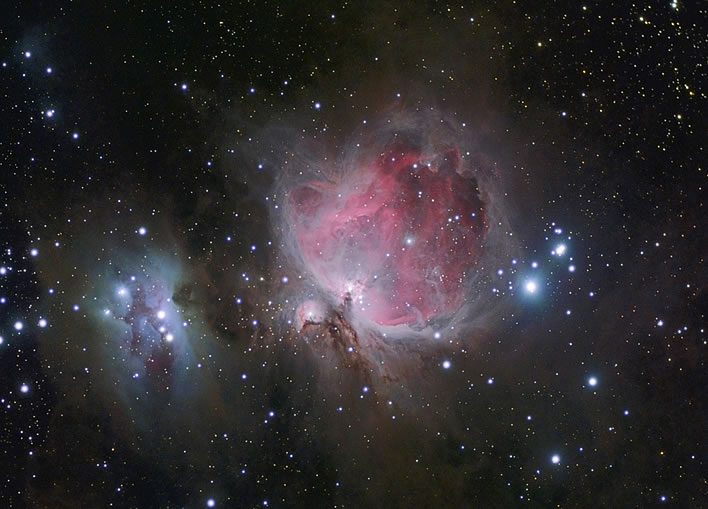
A closer view of the Orion nebula. Those interested can peer even further into this crucible of star formation. The astonishing progress in astronomical observation in the last fifty years corresponds to Frost's insight into the activity of 'splitting stars'. But if the layperson falls silent at the mysterious beauty of the clear winter skies seen with the naked eye, as we split those stars with our 'blame telescopes', then split them even further and further, each mystery unfolds into even greater mysteries. Image: ©Weather and Sky Photography.
We've looked and looked, but after all where are we?
Do we know any better where we are,
And how it stands between the night to-night
And a man with a smoky lantern chimney?
How different from the way it ever stood?
Robert Frost, 'The Star Splitter', from New Hampshire, A Poem; with Notes and Grace Notes, first published by Henry Holt and Company, New York, 1923. Online at gutenberg.org.
Philosophical note
'Our senses cannot perceive extremes', wrote Blaise Pascal, and the immensity of space and the enormity of time are simply incomprehensible to us.
All our everyday visual capacities fail us. We have no sense of perspective, otherwise we would appreciate that these objects are not equidistant from the earthbound observer on some celestial plane – the objects we see here are located at vastly different distances from us. Imagine the vertigo of gazing into that abyss! Instead it all seems flat and our senses have failed us once more.
Our star-splitter splits not only space but time: Betelgeuse is 500 light years away from us – the light that reaches our eyes today left the star around the time that Copernicus discovered the solar system and Luther started the Reformation; Rigel is 900 light years away – its light left around the time the Crusades began; the Orion Nebula is 1,600 light years away – the Roman Empire was twisting in its final convulsions when that light set out.
Robert Frost's insight is quite correct: the wonder of the night sky – 'our place among the infinities' – is not resolved by the star-splitter, it just becomes a cause of ever more manifold wonder.
Astronomical note
The constellation of Orion begins to appear in the sky in the course of November, hence the topicality of this article. By the middle of November Orion is throwing his leg over the eastern horizon at about 21:00 (local time everywhere) and it is fully visible and upright in the sky an hour or two after midnight. The time at which Orion throws his leg over the horizon gets earlier (by about four minutes every day) as the season progresses.
0 Comments UTC Loaded:
Input rules for comments: No HTML, no images. Comments can be nested to a depth of eight. Surround a long quotation with curly braces: {blockquote}. Well-formed URLs will be rendered as links automatically. Do not click on links unless you are confident that they are safe. You have been warned!